
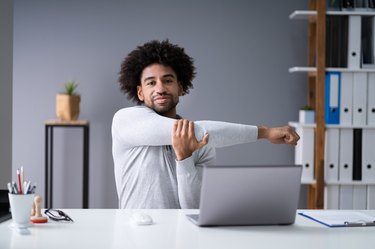
Anyone who works a desk job knows how not great it feels. And that's putting it nicely. Sitting all day can make things stiff, achy and downright painful. But there's relief in sight: Desk stretches can help mitigate the negative effects of sitting.
"Sitting, or holding any stationary posture, for an extended period of time is not great for the body," says Cameron Yuen, DPT, CSCS, senior physical therapist at Bespoke Treatments in New York City.
Video of the Day
"When we sit for too long, certain areas of our body get less blood flow, and muscles and joints lose their extensibility. This decrease in blood flow, stimulation and movement often leads to soreness, fatigue, cramping and discomfort."
While it's probably not possible to change your job description enough to avoid sitting completely, incorporating stretch sessions into your day can make a big difference. "To really make sure the muscles, connective tissue and joints stay healthy, it's good to move through full ranges of motion periodically," Yuen says.
How often should you stretch when working at a desk varies depending on your body and how you're feeling that day. But, "at a minimum, I recommend stretching every two hours, as this is practical for most people," Yuen says. Also, simply getting up and moving as often as possible can help increase blood flow and improve both physical comfort and your ability to focus.
"Use water and bathroom breaks to get on your feet and move a bit," Yuen says. "A longer walk before or after lunch is great as well."
Related Reading
When You Need a Break, Try These 10 Desk Stretches
Stretching during the day doesn't require going anywhere special. There are plenty of office chair stretches you can do right where you work. In fact, your chair can make for a helpful piece of equipment.
Below are 10 stretches for sitting all day for your neck and shoulders, hips, glutes, quads and more. Do them periodically throughout the day, and your body will thank you.
Want to post the stretches in your office? Download these printable desk stretches as a PDF.

Tip
For each exercise, 1 rep involves dynamically moving into the position to the point where you feel a good stretch, then backing out. This dynamic stretching technique is the best approach to get the blood flowing, Yuen says. But, if you prefer, you can also hold each one as a static stretch for 30 to 60 seconds.
Move 1: Standing Calf Stretch
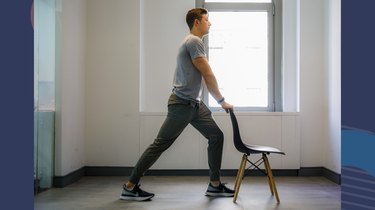
- Stand behind the back of your chair and place your hands on it for stability.
- Step one leg behind you and slightly bend your front leg.
- Press your back heel down and keep your leg straight as you lean into the front foot. You should feel the stretch in the calf of your back leg.
- Straighten your front leg and lift your back heel off the floor, then move through this stretch for 15 to 20 reps.
- Switch legs and repeat.
“This is a great stretch for breaking up a period of sitting, as it gets the ankle moving, helping return blood from the feet to the heart for circulation,” Yuen says.
Move 2: Standing Figure-4 Stretch
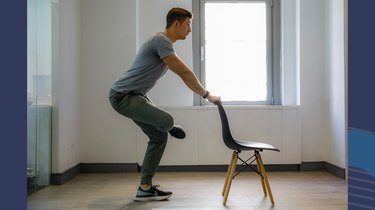
- Stand behind the back of your chair and place your hands on it for stability.
- Cross your right ankle over your left knee, then bend your left knee and hip to sit backward.
- Stand back up and move through this stretch for 15 to 20 reps.
- Switch legs and repeat.
When you sit all day, you sit right on top of your glutes (hello, office booty). This standing butt exercise helps relieve some of that pressure, gets the blood flowing and stretches out the hips, Yuen says.
Move 3: Office Chair Hip Flexor Stretch

- Stand in a split stance — one foot in front of the other — in front of your chair and facing away from it.
- Place the top of your back foot on the chair and bend your knees like you are doing a lunge. Keep your tailbone tucked as you do this.
- Straighten your legs to stand back up.
- Move through this stretch for 15 to 20 reps.
- Switch legs and repeat.
“The quads and hip flexors tend to get stiff after sitting for prolonged periods, and this stretch helps to open both,” Yuen says.
Move 4: Lateral Line Stretch
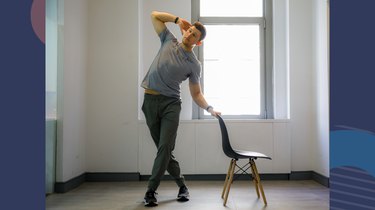
- Stand behind the back of your chair and place your left hand on it.
- Reach your right foot behind and across toward the left side of your body. Place your right hand behind your head and lean toward the left.
- Stand back up and move through this stretch for 15 to 20 reps.
- Switch sides and repeat.
This exercise you can do at work while standing opens up the entire side of your body from the IT band (to the side of your knee) all the way up to the neck, Yuen says.
Move 5: Back Stretch Sitting Down
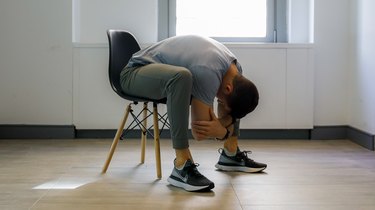
- While seated, set your feet and knees out wide.
- Fold forward, letting your lower back round and relax.
- Starting from your lower back and moving to your neck, slowly roll your spine back up.
- Move through this stretch for 15 to 20 reps.
The spinal erector muscles, which run along both sides of your spine and help keep your back straight, tend to get sore throughout the day, Yuen says. If you’re sitting upright, they’re constantly working. This sitting stretch gives them a chance to relax.
Move 6: Chair Hamstring Stretch
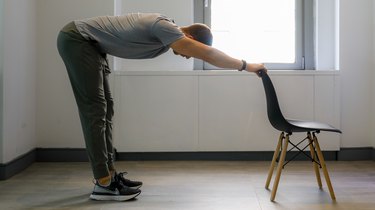
- Stand behind the back of your chair and place your hands on it.
- Walk your feet backward, hinge forward at your hips and straighten your knees. Lean forward, feeling the stretch in your hamstrings and back.
- Stand back up and move through this stretch for 15 to 20 reps.
Move 7: Seated Shoulder Stretch
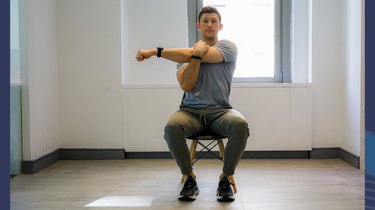
- Sit tall and cross your left arm across your chest.
- Keeping your shoulder blades stable, use your right arm to help pull your upper arm against your chest.
- Release, then move through this stretch for 15 to 20 reps.
- Switch arms and repeat.
The back of the shoulder tends to get tight when you’re slacking on posture and rounding forward a bit, Yuen says. This stretch can help loosen it up.
Move 8: Seated Thoracic Rotation
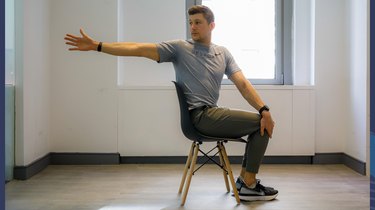
- Sit with your feet on the floor and grab the outside of your right knee with your left hand.
- Rotate your spine to face behind your chair. Simultaneously stretch your right arm toward the wall behind you.
- Release, then move through this stretch for 15 to 20 reps.
- Switch sides and repeat.
“A stiff thoracic spine [mid-back] can make movements like raising your arms overhead, reaching behind your back and even breathing difficult,” Yuen says. “This stretch focuses on opening the thoracic spine and rib cage, while also stretching the chest muscles.”
Move 9: Seated Triceps and Lat Stretch
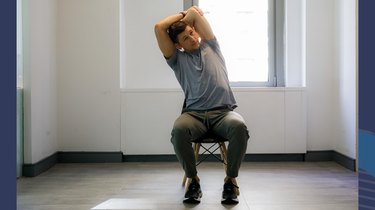
- Sit down and reach your left arm up overhead. Grab onto your elbow with your right hand, pulling and leaning over to right.
- Release, then move through this stretch for 15 to 20 reps.
- Switch arms and repeat.
Use this back stretch at work to open up the side of your body as well as your triceps and lats (side and mid-back).
Move 10: Upper Trapezius Stretch
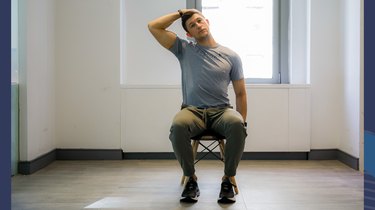
- While seated, hold the bottom of your chair with your left hand and pull your head gently up and over to the side with your right hand.
- Think about getting long and tall through your neck, rather than just pulling your head straight down to your shoulder.
- Release, then move through this stretch for 15 to 20 reps.
- Switch sides and repeat.
“This stretch focuses on the upper trapezius, which is a muscle that connects the neck to the shoulder,” Yuen says. “The upper traps tend to get sore as they help to stabilize the neck and shoulders.”
Want even more stretching in your life? This 10-minute routine will help you loosen up from head to toe.